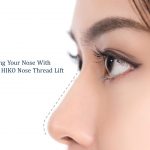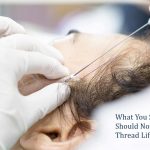What is Epicanthic Fold?
The epicanthic fold is a fold in the upper eyelid skin that covers the inner aspect of the eyes. This fold usually starts from the nose and ends at the inner corner of the eyebrow. It is associated with a higher fat deposition around the eyes. The greater amount of fat tissue provides a higher level of insulation from cold to the eyes and the sinuses surrounding it. A higher incidence of the epicanthic folds found in the Asian population is associated with descent from ancestors living in colder climates.
Is Epicanthic Fold Similar to Hooded Lid?
A hooded lid is a common facial feature in the Asian population, which is characterised by excess skin under the eyebrows. This may be seen in one or both eyes. This excess skin falls from the brow bone to the upper lash line. This makes the eyes seem hooded. On the other hand, epicanthic folds are formed on the inner corner of the eyes. These may start from the nose and extend to the inner half of the eyebrows. Hence, while they are similar, the hooded lid may affect the entire eye, while an epicanthic fold is found on the inner corners.
What Causes Epicanthic Fold?
Epicanthic fold may be formed due to several conditions, including underdevelopment of the nasal bone, an excess of the Orbicularis muscle, abnormal skin tension, or excess of skin over the medial canthus.
Medical Conditions That Promote Epicanthic Folds
The formation of epicanthic folds may also be caused by certain medical conditions, which include:
- Turner Syndrome
- Williams Syndrome
- Down syndrome
- Noonan Syndrome
- Phenylketonuria
- Rubinstein Taybi Syndrome
The medical condition which prevents the nasal bridge from completely developing is a common reason for epicanthic folds. One of these medical conditions is Down syndrome, which is also known as Trisomy 21. Data shows that at least 60% of individuals with Down’s syndrome have the presence of epicanthic folds.
Epicanthic Fold Prevalence
Epichanthal folds have a high prevalence, particularly in the East Asian population. Data shows its incidence to range between 40% and 90% in Asia. [12,13] However, it is not purely limited to Asian countries but may also be found in individuals belonging to a non-Asian background in 2 to 5% of the cases.
Types of Epicanthal Fold
There are four main Epicanthal folds: Epicanthus Suraculiaris, Epicanthus Palpebralis, Epicanthus Tarsalis and Epicanthus Inversus.
Type I: Epicanthus Supraciliaris
Epicanthus Supracilisairs is a type of epicanthic fold involving a vertical fold that extends from the middle of the eyebrows to the side of the nostrils. This fold usually ends over the anterior lacrimal crest. It obscures the caruncle and medial canthus.
Type II: Epicanthus Palpebralis
Epicanthus palpebral involves the formation of a skin fold which extends from the middle of the upper lid to the midpoint of the lower lid. This is the most common type of epicanthic fold and obscures the caruncle.
Type III: Epicanthus Tarsalis
Epicanthus Tarsalis is a type of epicanthic fold that starts to form from the lateral part of the eye and extends onto the entire eyelid. This fold ends at the medial canthus of the eye. Epicanthus Tarsalis is a common finding in Asian eyes.
Type IV: Epicanthus Inversus
The fourth type of epicanthus fold is known as the Epicanthus inversus. This is similar to epicanthus tarsalis, which has been discussed earlier. This involves forming a skin fold extending from the lower eyelid to the upper eyelid along the mid-pupillary line.
Epicanthal Fold Correction
Epicanthal Fold is popularly corrected through the epicanthoplasty procedure. This may also be referred to as medial or lateral Epicanthoplasty. This surgical procedure is conducted to lengthen the inner corner of the eye in order to make the eye appear bigger.
What Is Epicanthoplasty?
Epicanthoplasty is a common procedure in Asian countries, where it is also known as inner corner fold removal or Mongolian fold correction. It is opted for by both males and females who want to adopt a westernized look and make their eyes appear more alert and brighter. In addition, it is commonly requested by individuals with larger epicanthic folds, affecting their eye shape and negatively impacting their appearance. While this procedure is considered safe, it may leave post-surgical scarring due to the incision that is made. However, using more advanced techniques like Z-Plasty can further prevent the appearance of post-surgical scars.
What Happens Before Epicanthoplasty?
Before the Epicanthoplasty procedure, the surgeon will first conduct a pre-surgical analysis. Next, they will determine the severity of the type of epicanthic fold, which has been discussed over and their severity. Once the assessment is completed and the patient is considered a good candidate for the procedure, the doctor will then determine the details of the procedure, like the incisions to be made.
What Are The Types Of Epicanthoplasty?
There are two common types of Epicanthoplasty: Medial Epicanthoplasty and Lateral Epicanthoplasty.
As the name suggests, the medial Epicanthoplasty mainly focuses on the inner corner of the eye. Hence by removing the epicanthic fold from the inner corner of the eye, medial Epicanthoplasty is effective at making the eyes appear more open and alert. This may also help make slanted eyes appear straighter.
On the other hand, lateral Epicanthoplasty does not focus on the inner corner of the eye but instead targets the outer corner. Performing this procedure on Asian eyes can make them appear more elongated. It can also allow correction of the slanted eyes and make them appear straighter.
What Happens During Epicanthoplasty?
During Epicanthoplasty, the surgeon will start the procedure by administering local anaesthesia. Once the local anaesthesia has taken effect, the surgeon will start making incisions around the eye corners. These incisions are preplanned, which the surgeon has determined according to the patient’s unique case. Once the incisions are properly placed, the surgeon then creates flaps that can help restructure the shape of the eye. Finally, any excess skin that may be present is removed.
As mentioned earlier, if it is in a medial epicanthoplasty, the incisions are made to the inner corner of the eye, while in a lateral epicanthoplasty, the incision is made on the outer corner. Once the skin has been removed, the surgeon then closes up the eye again by placing fine sutures. The entire process is completed within 30 minutes. It may also extend up to one hour in some cases.
Suitable Candidates for The Surgery
Individuals who may be considered suitable candidates for Epicanthoplasty include:
- Those with a short horizontal length of the eyes
- Those who want a soft shape to their eyes and make them look less sharp
- Those who feel like their eyes are too far apart and want them to appear closer together
- Those who feel like their eyes are too small and want them to appear larger
What To Expect From Epicanthoplasty?
After the Epicanthoplasty is completed, the eyelids may appear slightly swollen and bruised during recovery. Therefore, the doctors advise a healing period of at least two weeks after the procedure, during which the individual should try to be extra cautious. The patients are recommended to avoid heavy exercises and extensive sports. Moreover, wearing eye makeup for at least a week after the surgery should also be avoided, as this may increase the chances of infection and post-surgical infections.
Once the recovery period is over, the patient can see the following benefits following Epicanthoplasty:
- Making the eyes appear closer to each other by reducing the intercanthal distance
- Making the eyes appear bigger and brighter by exposing the medial half of the eyes
- Revealing the medial corner of the eye and reducing the creases
- Making the eyes appear less slanted by shifting the medial canthus medially and upwards
Where to Get an Epicanthoplasty?
If you are planning to get an epicanthoplasty, it is important to first schedule a consultation with an experienced and specialised plastic surgeon. You should ensure that the surgeon you choose is a board-certified surgeon with a history of successful cases of Epicanthoplasty. A good surgeon usually shows you before and after pictures of their previous successful cases and how they achieved this. Moreover, you should also ensure that the surgery is conducted in a sterilised environment using the right equipment.
Final Thoughts
Epicanthal folds are a common finding in the Asian population. This is why the Epicanthal fold correction procedure, known as Epicanthoplasty, is a popular cosmetic procedure amongst this population. The epicanthic folds may be caused by several reasons, including the development of the nasal bone, medical conditions like Down syndrome or excess skin on the medial canthus, as seen in most Asians. While the majority of epicanthoplasty procedures are conducted for cosmetic reasons, some individuals may also opt for it due to vision obstruction. In this case, an epicanthoplasty can not only make the eyes appear bigger but may also help the patient to see well.
About Dream Aesthetics and Plastic Surgery
Bespoke surgical for cosmetic or medical reasons is what Dream covers to bring out the beauty in every individual. Going beyond the aesthetics and working on physical anomalies are what we value the most in leading our patients to cherish self-improvement and confident lifestyles.
Derived from Associate Professor Vincent Yeow’s long-standing experience performing plastic surgery in Singapore, our treatment plans deliver physical remodelling in our patients’ favour. One of the notable remodellings is droopy eyelid correction. The ptosis surgery used for treatment eventually fixes drooping eyelids, improves vision and enhances appearance.
Most importantly, as a trustworthy plastic surgery and aesthetic clinic, we treasure positive and natural outcomes for each individual. We will ensure to deliver the beauty refinement of your dream without compromising your safety and privacy.







